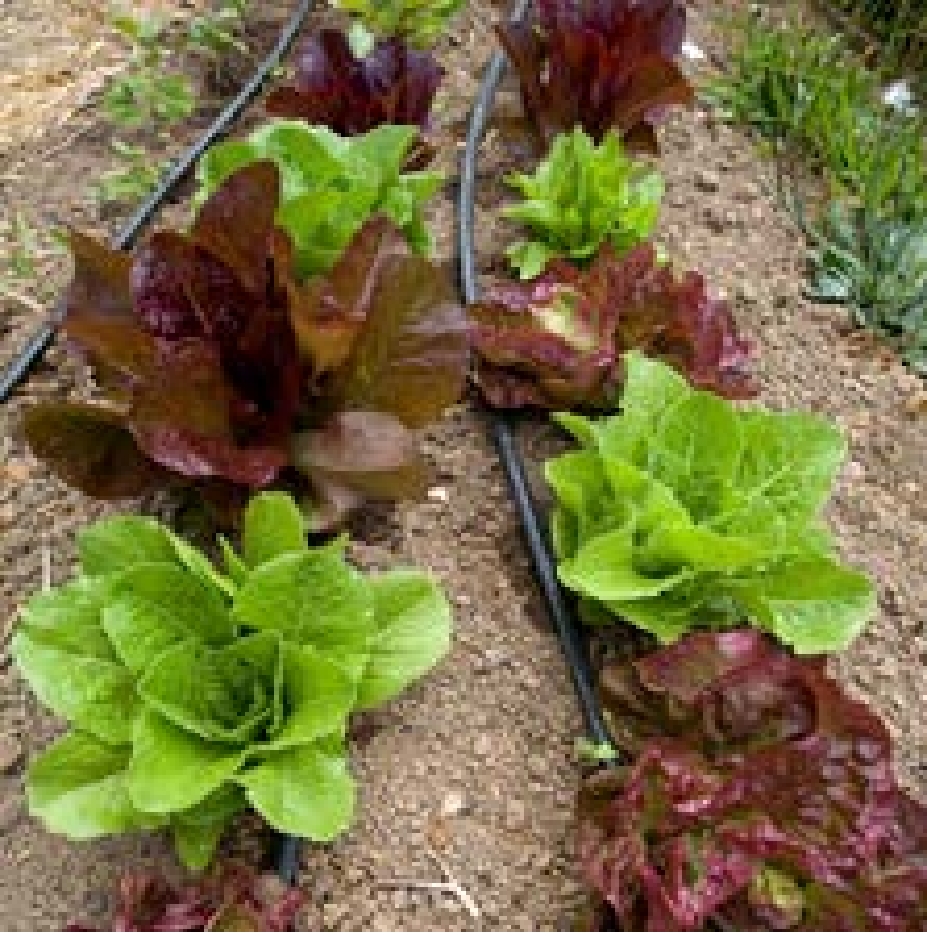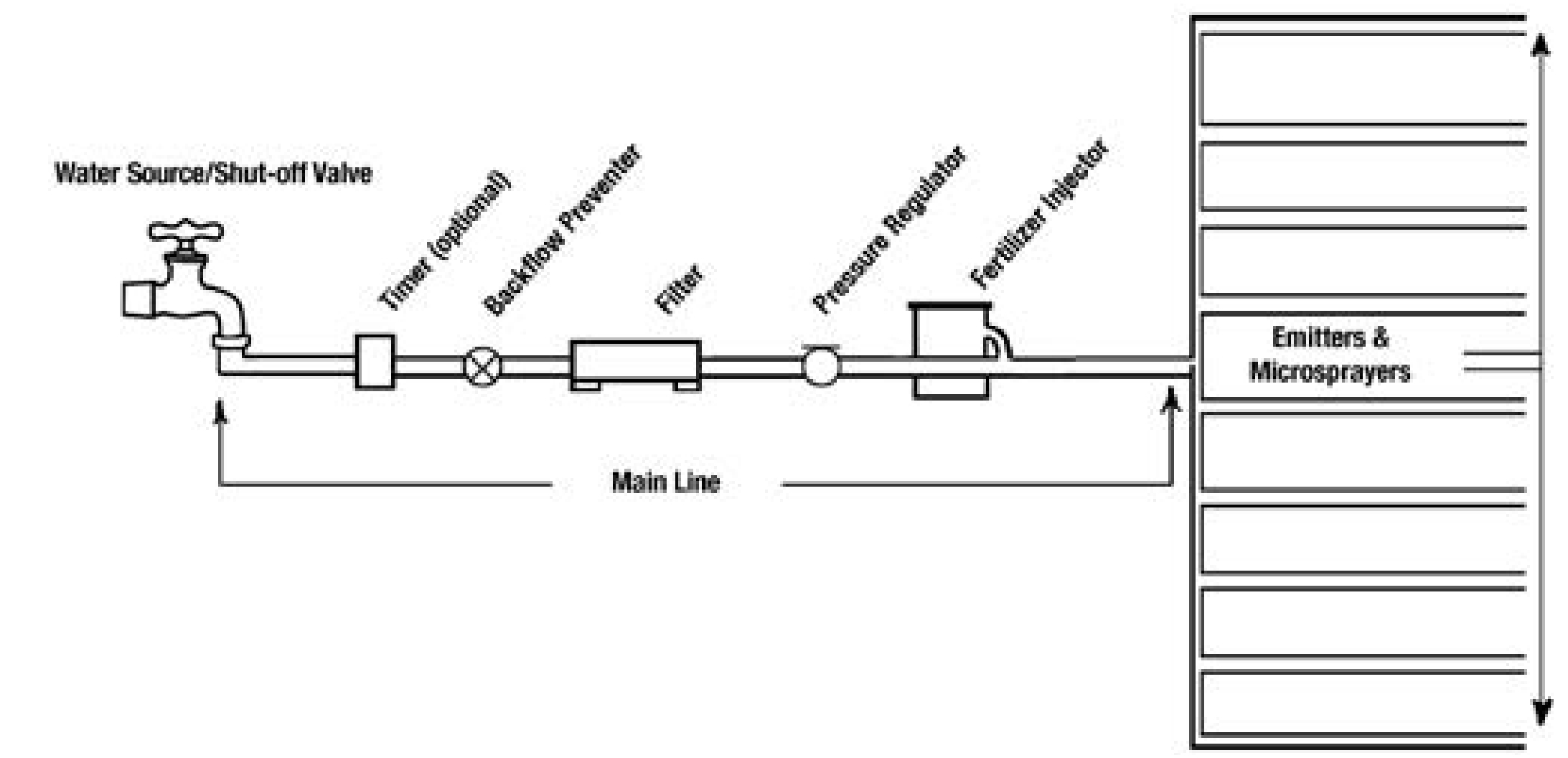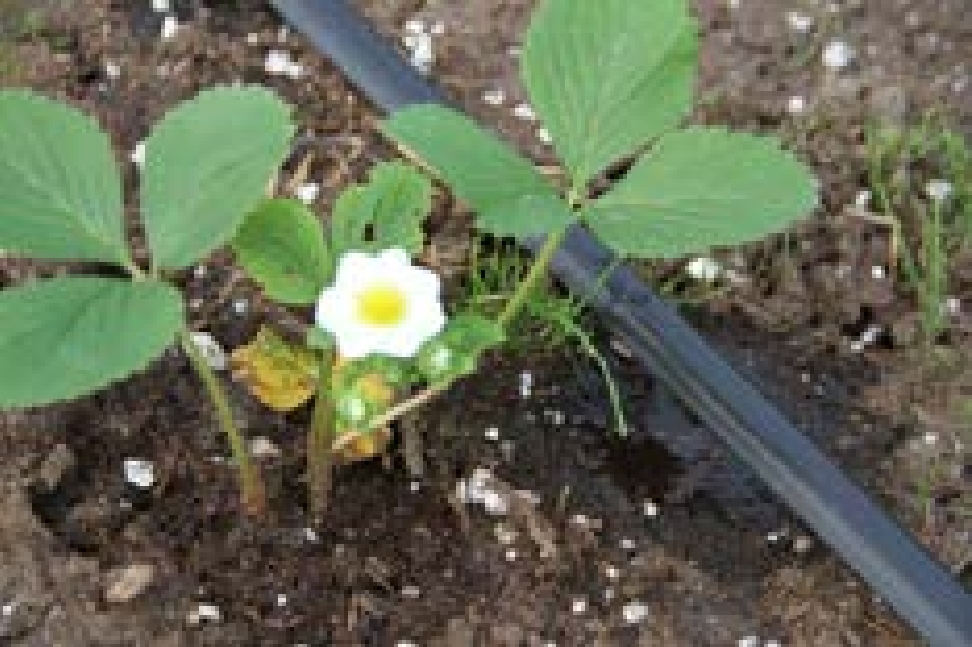Drip Irrigation for Alaska Gardens
FGV-00648 View this publication in PDF form to print or download.
Drip irrigation, also known as trickle irrigation or microirrigation, is a method of slowly applying small amounts of water to plant root zones, with the goal of applying only the water plants need. This method allows irrigation managers to maintain a favorable balance of air and water in the soil, resulting in better plant growth. Drip irrigation is effective in most growing situations, but especially in areas of Alaska that have extended periods of dry weather and limited water supplies during the growing season, or where runoff is a problem. Small home garden systems are fairly simple to install. A garden or landscape with numerous different zones might benefit from enlisting the help of a knowledgeable contractor.
Advantages of Drip Irrigation
There are many advantages to using drip irrigation instead of overhead irrigation.
Drip irrigation uses water more efficiently. It applies water directly above or on the area requiring irrigation, thus minimizing the loss of water due to runoff, wind and evaporation. It exceeds 90 percent efficiency whereas above-ground watering systems are only 50 to 70 percent efficient.
It uses less energy. Drip irrigation requires lower operating pressure (the force pushing the water) and flow rates and is better suited for gravity-fed systems.
It reduces pest problems. Drip irrigation eliminates many of the disease and insect problems caused by moisture application to plant foliage and reduces plant stress from improper soil moisture.
Drip irrigation makes weed management and tillage easier. Weed problems are often reduced because water is applied directly to crops and is not available to weeds. Additionally, tillage and other garden chores can continue during irrigation since only small areas around the plant are watered.
It applies fertilizer more accurately. Water-soluble fertilizer can be applied through the irrigation system and delivered directly to the root zone of crops, reducing fertilizer requirements and weed problems.
Drip irrigation systems can provide warmer water. Lower operating pressures and flow rates mean that water can be stored above ground in tanks where it can be warmed by the sun and applied by pumps or gravity-fed systems.
It is easily automated. Drip irrigation systems can be controlled by a timer or a smart controller that adjusts irrigation based on the current weather and past irrigation schedules. Some can be controlled remotely on a mobile phone or other wireless device.
Drip irrigation is versatile. Drip irrigation systems can be easily adapted, changed, expanded or reduced as needed.

Potential Problems
- The small emitters are easily clogged by soil particles, algae or minerals. Proper installation, clean water and a filtering system are essential for success.
- The spacing of emitters in the drip irrigation lines must match or be close to the spacing of garden plants. There should be a minimum of one emitter per plant.
- Drip irrigation system components are susceptible to damage from animals and humans.
- It is not always easy to determine when water should be added, especially if plastic mulch is used on the soil surface. Tensiometers (used to measure the availability of soil water) are recommended for beginning gardeners.
- Water system back-siphoning into a well or water source can be a problem. An anti-backflow device should be installed on the distribution line.
Drip Irrigation System Components
- Shutoff valves can be opened or closed to allow or prevent the flow of water into the system. Valves can be operated manually or by an electronic controller to automate irrigation.
- Controls are available to help automate irrigation systems. The most beneficial control device
is a timer, which helps take the guesswork out of how much to water and when.
Typical timer options include AC electric timers that require access to power; DC battery timers; windup timers that require no power source; battery timers that must be manually started; and zero-pressure battery timers for gravity-fed irrigation systems. - Backflow preventers are one-way valves that keep contaminated water in a drip system from flowing back
into the water source in the case of a sudden loss of pressure. This is particularly
important if water is sourced from a well or municipal water supply. Check with your
government building department or water provider to determine what backflow prevention
is required locally.
A double check valve does the best job of preventing backflow but it's also the most expensive. A vacuum breaker works if it is mounted at least a foot above your entire drip-irrigation system but it's not rated for constant pressure. Check valves are generally not approved backflow preventers. - Filters are used to remove sand and large organic particles from source water that might plug irrigation emitters. The larger the filter’s mesh count, the smaller the filter screen openings. For example, a screen with a mesh count of 200 would filter out smaller particles than would a screen with a mesh size of 150. For most irrigation systems a mesh size of 15–200 is adequate.


- Pressure regulators maintain water pressures entering the system at levels appropriate for the drip irrigation equipment. Typically, drip irrigation systems are designed around water pressures that are less than that of standard residential water pressures. Low-pressure gravity systems may not need a regulator.
- Fertilizer injectors insert nutrients directly into irrigation water, allowing the placement of nutrients directly in the plant root zone.
- Distribution lines carry water from the source to emitters. These can be garden hoses, UV-resistant PVC pipes or a softer material that is designed to have holes punched into it as needed.
- Emitters and microsprayers are small irrigation devices used to deliver a regulated amount of water to a specific
location or plant. These are both basic devices that work best at a specific water
pressure and use pressure-compensating regulators that have a built-in flow regulator
to deliver the same amount of water regardless of pressure changes.
Microsprayers are just that, small sprayers that distribute water as large droplets or a stream. They can be tailored to cover specific areas, such as a full circle, half circle or quarter circle.
Emitters are available in two types:
A line-source emitter is used for closely spaced row crops and greenhouses. It is a porous tube with a series of equally spaced holes or small openings. The flow rate is typically given as gallons per hour (gph) and ranges from 0.1–2 gph per 100 feet of line. On level ground, lines can be up to 300 feet. The operating pressure is low and ranges from 2–30 pounds per square inch (psi); any change in elevation causes large variation in flow rates.
A point-source emitter is often used for areas with unequally spaced plants, such as landscapes or container-grown nursery crops. The point-source emitter is an individual emitter that can be placed as close as necessary to plants requiring irrigation. The flow rates range from 0.25 to 2 gph and operate under pressures from 5-60 psi. - Monitoring equipment should be used to assess the soil moisture levels after irrigation to ensure that sufficient but not excessive soil moisture levels are achieved. A tensiometer or similar device can be used to obtain sufficient estimates of soil moisture levels and is especially useful in situations where mulch or row cover is present.
Choosing Water Sources
Water sources for drip irrigation include treated municipal water, well water and surface water (ponds, streams or rivers). Regardless of which water source is used, clean water is essential.
Ground water sources are typically the best suited for use with drip irrigation. Surface water sources can contain bacteria, algae and small sand or soil particles and will require more elaborate filters and frequent cleaning. Clogging of emitters by physical contaminants is the single biggest challenge to using drip irrigation. A filtration device should be installed and cleaned regularly for all drip irrigation systems.
Fertilizer Injection
It's easy and efficient to add water-soluble fertilizer to a drip irrigation system where it is delivered directly to a plant's root zone for uptake. Special attention should be paid to the amount of fertilizer applied using drip irrigation systems. Often, the amount of fertilizer required with drip irrigation applications is reduced, in some instances by 50 percent.


Drip Irrigation and Plastic Mulch
Water use efficiency is increased when drip irrigation is used under plastic mulches. Mulches limit the evaporation of water supplied to the soil. One design uses line-source emitters installed down the center of cropping rows, which are then covered with plastic mulch. Plastic mulch can be used with both direct-seeded and transplanted crops. For more information on using plastic mulches, see Plastic Mulch and Row Covers for Vegetable Production in Alaska, FGV-00647.
Potential Challenges
Regular maintenance of the system is required. Because emitters and microsprayers can become clogged, clean water, a filtration system and regular inspection of distribution lines and emitters are essential for success.
Proper emitter spacing is a must to ensure proper root development and reduce moisture stress on plants. Plants need a minimum of one emitter.
Determining the duration and frequency of irrigation can be a challenge. There are monitoring tools to assist with this. There are numerous smart irrigation controllers available as well, however, they may be overkill for a home garden.
Contamination of water sources from back siphoning can occur, and a backflow preventing device should be installed at the beginning of the system.
UAF Cooperative Extension Publications
Managing Irrigation for High-Value Crops, FGV-00649
Plastic Mulch and Row Covers for Vegetable Production in Alaska, FGV-00647
Small-Scale Irrigation Options, FGV-00646
Related Websites
Irrigation Tutorials, www.irrigationtutorials.com/
U.S. Environmental Protection Agency. WaterSense, https://www.epa.gov/watersense
USDA Natural Resources Conservation Service. Irrigation, http://go.usa.gov/Kow
Other Resources
Hutchinson, Mark. 2003. Trickle Irrigation: Using and Conserving Water in the Home Garden. University of Maine Cooperative Extension Bulletin 2160, https://extension.umaine.edu/publications/2160e/
Schuch, U. 2016. Drip Irrigation: The Basics. University of Arizona Cooperative Extension Service. https://extension.arizona.edu/sites/extension.arizona.edu/files/pubs/az1392-2016_0.pdf
Wilson, C., and M. Bauer. 2005. Drip Irrigation for Home Gardens. Colorado State University Extension Fact Sheet No. 4.702, http://extension.colostate.edu/topic-areas/yard-garden/drip-irrigation-home-gardens-4-702/
Heidi Rader, Extension Faculty, Agriculture and Horticulture. Originally prepared by Jerry Purser, former Extension Agriculture Development Agent.
Reviewed September 2021
